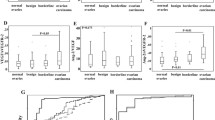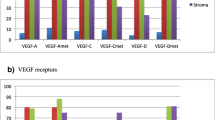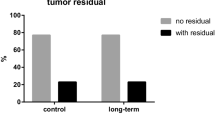Abstract
Objective
The objectives were to study the expression of vascular endothelial growth factor (VEGF), cyclooxygenase-2 (Cox-2), and Bcl-2 in borderline ovarian tumors (BOTs) and the relationship within them, and to investigate the correlation between expression of VEGF, Cox-2, and Bcl-2, and the clinicopathologic features of BOTs.
Methods
An immunohistochemical technique was used to investigate the expression of VEGF ,Cox-2, and Bcl-2 in 69 borderline, 18 benign, and 27 malignant human ovarian tumor tissues.
Results
Expression rate of VEGF protein (59.4%) in BOTs was higher than in benign tumors (27.8%) and was lower than in ovarian carcinomas (92.6%), and there was a significant difference between BOTs and benign ovarian tumors (p<0.05), and carcinoma (p<0.01). Significant correlation was observed between the positive expression rate for VEGF and clinical stage of BOTs (p<0.05). The statistical analysis did not show a close correlation between the expression of VEGF and tissue type, and peritoneal implants in BOTs (p>0.05). The expression rate of Cox-2 was significantly higher in ovarian carcinomas (81.5%) than in BOTs (57.9%) and in benign ovarian tumors (38.9%) (p<0.05). Significant correlation was observed between the positive expression rate for Cox-2 and the clinical stage of BOTs (p<0.05). The statistical analysis showed no close correlation between the expression of Cox-2 and tissue type, and peritoneal implants in BOTs (p>0.05). There was a significant difference between the expression of Bcl-2 in ovarian carcinomas and BOTs than that in benign ovarian tumors (p<0.05). The positive expression rate of Bcl-2 was not related to clinical stages and peritoneal implants (p>0.05). Statistical analysis showed a positive correlation between the expression of Cox-2 and VEGF, and Bcl-2 in BOTs.
Conclusions
Overexpression of VEGF, Cox-2, and Bcl-2 in BOTs may play an important role in the oncogenesis and progression of BOTs. It is feasible to detect VEGF, Cox-2, and Bcl-2 in the diagnosis and to predict the prognosis of BOTs.




Similar content being viewed by others
References
Smith WL, Garavito RM, DeWitt DL (1996) Prostaglandin endoperoxide H synthases (cyclooxygenase)-1 and −2. J Biol Chem 271:33157–33160
Vane J (1994) Towards a better aspirin. Nature 367:215–216
Eberhart CE, Dubois RN (1995) Eicosanoids and the gastrointestinal tract. Gastroenterology 109:285–301
Shi H, Xu JM, Hu NZ, Xie HJ (2003) Prognostic significance of expression of cyclooxygenase-2 and vascular endothelial growth factor in human gastric carcinoma. World J Gastroenterol 9:1421–1426
Tucker ON, Dannenberg AJ, Yang EK, Zhang F, Teng L, Daly JM, Soslow RA, Masferrer JL, Worener BM, Koki A, Fahey TJ (1999) Cyclooxygenase-2 expression is up-regulated in human pancreatic cancer. Cancer Res 59:987–990
Hwang D, Scollard D, Byrne J, Levine E (1998) Expression of cyclooxygenase-1 and cyclooxygenase-2 in human breast cancer. J Natl Cancer Inst 90:455–460
Wolff H, Saukkonen K, Anttila S, Karjalainen A, Vainio H, Ristimaki A (1998) Expression of cyclooxygenase-2 in human lung carcinoma. Cancer Res 58:4997–5001
Weidner N, Folkman J, Pozza F, Bevilacqua P, Allred EN, Moore DH, Meli S, Gasparini G (1992) Tumor angiogenesis: a new significant and independent prognostic indicator in early-stage breast carcinoma. J Natl Cancer Inst 84:1875–1887
Dvorak HF, Brown LF, Detmar M, Dvorak AM (1995) Vascular permeability factor/vascular endothelial growth factor, microvascular hyperpermeability, and angiogenesis. Am J Pathol 146:1029–1039
Song ZJ, Gong P, Wu YE (2002) Relationship between the expression of iNOS, VEGF, tumor angiogenesis and gastric cancer. World J Gastroenterol 8:591–595
Folkman J (1990) What is the evidence that tumors are angiogenesis dependent? J Natl Cancer Inst 82:4–6
Kim HS, Youm HR, Lee JS, Min KW, Chung JH, Park CS (2003) Correlation between cyclooxygenase-2 and tumor angiogenesis in non-small cell lung cancer. Lung Cancer 42:163–170
Gadducci A, Ferdeghini M, Fanucchi A, Annicchiarico C, Ciampi B, Prontera C, Genazzani AR (1999) Serum preoperative vascular endothelial growth factor (VEGF) in epithelial ovarian cancer: relationship with prognostic variables and clinical outcome. Anticancer Res 19:1401–1405
Tao HQ, Lin YZ, Wang RN (1998) Significance of vascular endothelial growth factor messenger RNA expression in gastric cancer. World J Gastroenterol 4:10–13
Wyllie AH (1995) The genetic regulation of apoptosis. Curr Opin Genet Dev 5:97–104
Reed JC (1994) Bcl-2 and the regulation of programmed cell death. J Cell Biol 124:1–6
Kitagawa Y, Wong F, Lo P, Elliott M, Verburgt LM, Hogg JC, Daya M (1996) Overexpression of bcl-2 and mutation in p53 and K-ras in resected human non-small-cell lung cancers. Am J Respir Cell Mol Biol 15:45–54
Parenti AR, Rugge M, Shiao YH, Ruol A, Ancona E, Bozzola L, Ninfo V (1997) Bcl-2 and p53 immunophenotypes in pre-malignant, early and advanced esophageal squamous cancer. Histopathology 31:430–435
Wikonkal NM, Berg RJ, van Haselen CW, Horkay I, Remenyik E, Begany A, Hunyadi J, van Vloten WA, de Gruijl FR (1997) Bcl-2 versus p53 protein expression and apoptotic rate in human nonmelanoma skin cancers. Arch Dermatol 133:599–602
Hori M, Nogami T, Itabashi M, Yoshimi F, Ono H, Koizumi S (1997) Expression of bcl-2 in human breast cancer: correlation between hormone receptor status, p53 protein accumulation and DNA strand breaks associated with apoptosis. Pathol Int 47:757–762
Gately S (2000) The contributions of cyclooxygenase-2 to tumor angiogenesis. Cancer Metastasis Rev 19:19–27
International Federation of Gynecology and Obstetrics (1987) Changes in definitions of clinical staging for carcinoma of the cervix and ovary. Am J Obstet Gynecol 156:246
Leung DW, Cachianes G, Kuang WJ, Goedel DV, Ferrara N (1989) Vascular endothelial growth factor is a secreted angiogenic mitogen. Science 246:1306–1309
Trefan OC, Hla T (2003) Cyclooxygenase-2 modulates cellular growth and promotes tumorigenesis. J Cell Mol Med 7:207–222
Murata H, Kawano S, Tsuji S, Tsuji M, Sawaoka H, Kimura Y, Shiozaki H, Hori M (1999) Cyclooxygenase-2 overexpression enhances lymphatic invasion and metastasis in human gastric carcinoma. Am J Gastroenterol 94:451–455
Ohno R, Yoshinaga K, Fujita T, Hasegawa K, Iseki H, Tasunozaki H, Ichikawa W, Nihei Z, Sugihara K (2001) Depth of invasion parallels increased cyclooxygenase-2 levels in patients with gastric carcinoma. Cancer 91:1876–1881
McConkey DJ, Chandra J, Wright S, Plunkett W, McDonnell TJ, Reed JC, Keating M (1996) Apoptosis sensitivity in chronic lymphocytic leukaemia is determined by endogenous endonuclease content and relative expression of BCL-2 and BAX. J Immunol 156:2624–2630
Henriksen R, Wilander E, Oberg K (1995) Expression and prognostic significance of Bcl-2 in ovarian tumors. Br J Cancer 72:1324–1329
Chan WY, Cheung KK, Schouge JO, Huang LW, Welch WR, Bell DA, Berkowitz RS, Mok SC (2000) Bcl-2 and p53 protein expression, apoptosis, and p53 mutation in human epithelial ovarian cancers. Am J Pathol 156:409–417
Chan WY, Yew DT (1998) Apoptosis and bcl-2 oncoprotein expression in the human fetal central nervous system. Anat Rec 252:165–175
Novak VD, Korsmeyer SJ (1994) Protein expression during murine development. Am J Pathol 145:61–73
Fosslien E (2001) Molecular pathology of cyclooxygenase-2 in cancer-induced angiogenesis. Ann Clin Lab Sci 31:325–348
Acknowledgements
This work was supported by the Science Foundation of the Education Department of Gansu (02B3—01).
Author information
Authors and Affiliations
Corresponding author
Rights and permissions
About this article
Cite this article
Li, M., Qi, SY., Wang, Y. et al. Expression and clinical significance of vascular endothelial growth factor, cyclooxygenase-2, and Bcl-2 in borderline ovarian tumors. Arch Gynecol Obstet 272, 48–52 (2005). https://doi.org/10.1007/s00404-004-0708-9
Received:
Accepted:
Published:
Issue Date:
DOI: https://doi.org/10.1007/s00404-004-0708-9




